KIM SETS STAGE FOR GOLD, ASADA ATTEMPTS TO
CHALLENGE WITH TRIPLE AXEL
ROCHETTE GIVE HEART WRENCHING PERFORMANCE TO PLACE THIRD
The first two warm-ups of lesser-lights had their sights set on making the cut to 24 skaters and striving for a best effort in the most important competition of their careers thus far. Four ladies put their season best performance on the ice, and for three is was enough to make the final round, with six of the ten ladies making he final round, as they twisted in the wind waiting for results from the later groups.
The first two warm-ups as won by Ksenia Makarova, of the Russian Federation. Skating in a lavender dress to "Ladies in Lavender" is was a modestly emotional performance skated at better then average speed, though not particularly strong. She struggled for all the landings on the jumps, with triple toe loop - triple toe loop fairly clean, but a dicey triple flip which six judges marked down. Her flying sit spin also was weak, though it achieved level four, but was scored at -1 by seven judges. Her components were near six, slightly above average for a slightly above average performance.
During the warm-up Johnny Weir was at the boards with the skater, at which some looked askance. But Weir has worked with the skater with her main coach Galena Zmievskaia, so it is perhaps not that odd -- and if Russians can coach American skaters, there should be no issue with Americans coaching Russian skaters (or skaters from any other country as some do).
Things picked up in the next two warm-up, with eight of the ten skaters making the final round.
Mirai Nagasu led off the third warm-up with a season best performance of 63.76 points. It gave her temporary command of first place, which she held through the end of these two groups, giving hope of perhaps a top five finish.
It has been hyped in the days prior to the event that she would attempt triple Lutz - triple toe loop, and practice on that element had been going well at home prior to the games. But when it was time to skate she opened with a triple double, with an edge alert call on the triple Lutz, which resulted in the element being scored in GoE at -1.20. After her performance she said, "I think I made the right choice. My landing was not the best landing so it's good I did the double."
The jump combination was the only element scored negative in GoE. She achieved level 4 on three elements, and level 3 on too others, with most of her GoEs from +1 through +3. She seemed relaxed and confident through the performance with component scores that averaged near 6.75. Her closing spin was a very well executed level 4 change foot combination spin scored with three +3s and six +2s, and at some point in the spin she developed a bloody nose (or at least that is when it became apparent in photographs).
After her performance, the skater and American fans has a long wait to see how well her marks would hold up, and whether an American lady had even an outside chance to reach the podium. In the end Nagasu placed sixth in the Short Program, 7.4 points behind third place, with a numerical chance to medal, but not a likely one.
The second best performance from these two groups came from Elene Gedevanishvili of Georgia. It was nicely skated season best performance to "Fever" which garnered 61.92 points. Her opening triple Lutz was marked down by six of the nine judges, but she followed with a clean triple toe loop - triple toe loop combination. "I knew that I had done everything I could. I knew I had worked really hard," she said afterwards. " I mean, my performance tonight was much better than at the European Championships. I did a triple-triple. I really enjoyed it." Gedevanishvili also completed double Axel, and her spins and steps achieved level 3 for tow elements, and level four for three. She ended the night in ninth place with a good chance for a top ten finish.
After the second ice cut, the energy level in the arena was cranked up with the two top contenders skating back to back in the fifth warm-up. Mao Asada had drawn second to skate on the group and was followed by Yu-Na Kim. For the Short Program Asada's strategy was to exploit the point value of her triple Axel, while Kim's approach was to counter with a triple-triple combination and an all around balanced performance.
Asada opened with her planned triple Axel - double toe loop combination, which took off high and fast. It was scored by the judges slightly positive, with GoE points of 0.60. Photos of the element show the landing of the triple Axel was just under 1/4 under-rotated and the landing of the double toe loop seems two footed, so it could be argued the marks for this element are fairly generous.
On triple flip, which has vexed Asada in the, she landed the jump but three judges scored it at -1 and six at +1. Go figure. Double Axel was clean, and she achieved level 4 on four of five spins and steps, with level 3 on her straight line step sequence. Asada gave an enthusiastic performance and was really into it for the step sequence and closing combination spin. Didn't quite get the concept though. The girl is going to be poisoned and die at the end of the ball she is attending. She seemed awfully happy for a tragic character.
Asada's season best score of 73.78 put the pressure on Kim to produce a season best performance of her own, and she came through. She cleanly landed triple Lutz - triple toe loop, triple flip and double Axel. All her elements but the step sequence were called level 4, with the sequence at level 3. Her lowest GoE was as single 0 on the triple flip. She outscored Asada on base value, GoE value and components, with an average component score near 8.5, but with her Transitions mark distinctly lower at 7.9. The routine was well skated, but is artistically superficial. But then artistic sophistication is not part of the scoring. Kim's season best score of 78.50 gave her a lead that any other skater yet to come could likely beat, and from this point in the competition it was a matter of who might at least stay in the running for the long program.
Canadian Joannie Rochette leading off the last warm-up group, was warmly greeted by the crowd, with everyone well aware of the emotional strain she was under with the sudden death of her mother here in Vancouver two days earlier. Rochette performed with composure and determination and gave her own season best performance to "La Cumparista," a tango routine. Only at the end was she overwhelmed with emotion as she tearfully left the ice. It was well executed, solid performance with good tango expression. Her component marks averaged just above 8.0, with Interpretation her highest mark of the five. She cleanly landed her elements without a single negative GoE. Her TES was slightly compromised by a level 2 layback spin and the lack of a triple-triple to answer Kim's or Asada's higher value combinations. She was scored third best, and ended the night with a 6.6 margin over Miki Ando, positioning her well to at least capture the bronze. Had the errors in Asada's combination been noticed by the judges, she likely would have ended the night in second place.
The second U.S. competitor, Rachael Flatt, skated third in the last warm-up. Flatt too delivered a season best performance, that just edged her ahead of Nagasu by 0.9 points. Her "Sing, Sing, Sing" routine was well delivered, though not a strong in our view, as at U.S. Nationals in January. She cleanly landed her opening triple flip - triple toe loop combination, but her subsequent triple Lutz appeared two footed and the judges scored it at -1.00. She achieved level 4 on two spins and her spiral sequence, but her level 2 layback spin pulls down her element score. Her step sequence was level 3, as was achieved by most of the top ladies. The flip was the only element to receive negative GoEs, and her component marks averaged just under 7.0. On her performance she said, "It was so exciting. I really performed my program well, and that was my goal, so I'm Ecstatic about how things went." By moving ahead of Nagaus, Flatt ended the night in fifth place, and the two U.S. ladies enter the Free Skate in fifth and sixth place.
Last to skate in the segment was Miki Ando. Considered to have an outside chance at a medal, she may have let that slip away with a serious error on her opening triple Lutz - triple toe loop operation. The toe loop was downgraded and the panel GoE value was -1.20, though two judges gave a GoE of 0. The error cost her at least 4.20 points which she could not afford to give away. Describing the jump she said, "I did not get enough rotation on my triple Lutz - triple lop. That was pretty bad. I really wanted to do it well."
Ando also was scored down on her subsequent triple flip, which four judges scored with negative GoEs. She lost another 0.60 points there. She fared better in spins and steps, with three level 4s and two level 3s. These elements were well executed, none of which received a negative GoE, though all were roughly one GoE below Kim. She finished big with a nice combination spin that received eight marks of +2. Her performance to Mozart's Requiem was typical Morozov melodrama and was scored with components that averaged near 7.5.
Looking forward to the Free Skate. The conventional wisdom is that the top three in the Short Program will be the podium. Asada has a numerical chance to overtake Kim, but will need two clean triple Axel's to overcome the limitations elsewhere in her program. Kim will need a clean all around solid performance, and that may be enough to win the gold event if Asada lands both Axels. For Rochette it will come down to her mental and emotional toughness. If Asada falters in her jumps and Rochette has a solid skate she could move up to the silver.
Ando will need a much stronger performance in the long, and some help from the top ladies by falling down, to reach the podium. The best the U.S. ladies can hope for, barring help from those skaters ahead, is to hold onto fifth and sixth place, with Nagasu having a good shot at overtaking Flatt. A fifth-sixth finish would be a credible result fro the U.S. and if the ladies could repeat it at Worlds net month the U.S. could recover it's third berth for next year.
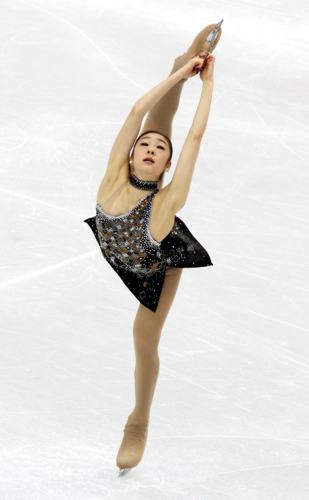 |
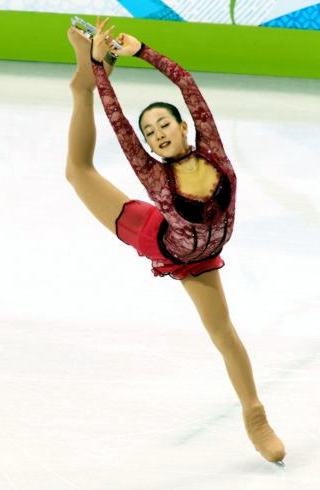 |
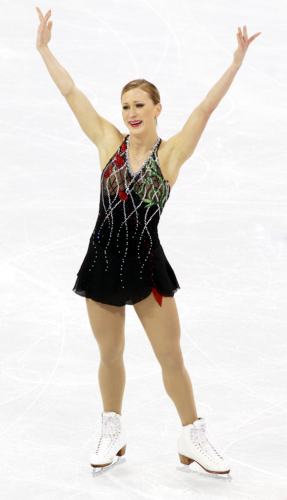 |
| Yu-Na Kim -- First | Mao Asada -- Second | Joannie Rochette Third |
 |
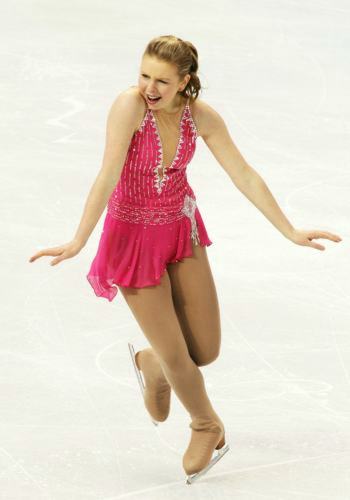 |
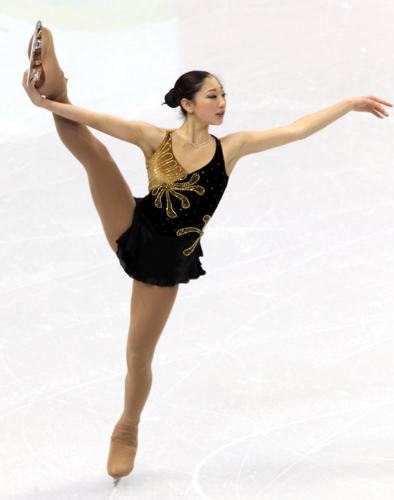 |
| Miki Ando -- Fourth | Rachael Flatt -- Fifth | Mirai Nagasu Sixth |
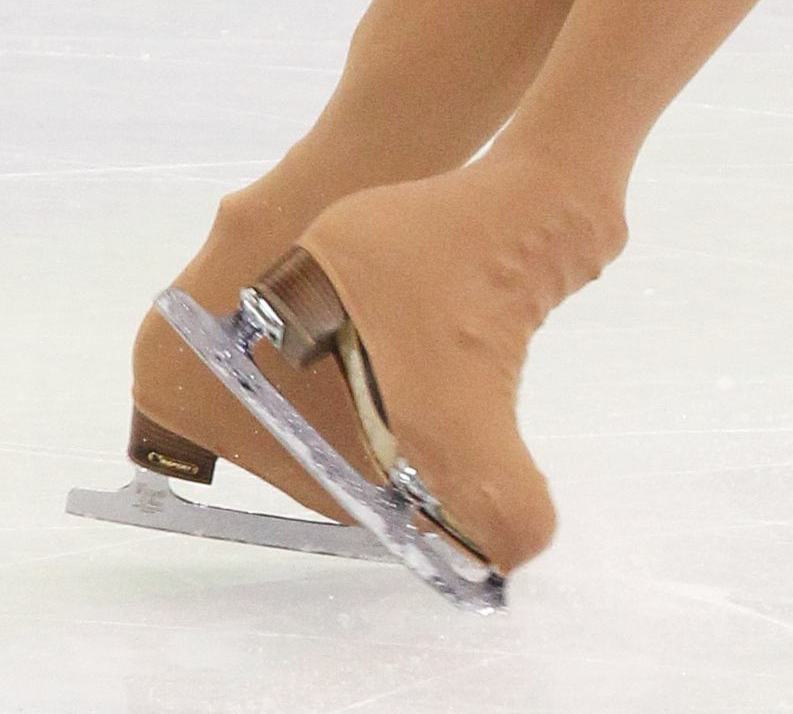 |
|
|
Two footed 3A+2T? The difference between 2nd and 3rd place? Compare landing of 2T on left with shape of blade on the right. |
|
Copyright 2010 by George S. Rossano